Searching for New Objects with the B[e] Phenomenon
Abstract
1. Introduction
2. Methodology
3. Observations
| Observatory | D, m | Δ λ, μm | R = λ/Δλ | Ref. |
|---|---|---|---|---|
| Bol. | 1.52 | 0.40–0.70 | ∼800–1500 | BFOSC * |
| HCT | 2.00 | 0.40–0.70 | ∼800–1500 | HFOSC [17] |
| OAN SPM | 2.12 | 0.40–0.70 | ∼18,000 | REOSC [18] |
| LO | 3.00 | 0.46–2.50 | ∼700 | NIRIS [19] |
| CFHT | 3.60 | 0.36–1.05 | ∼60,000 | ESPaDoNs [20] |
| IRAS ID | HJD | V | B − V | V − R |
|---|---|---|---|---|
| 00040 + 6518 | 2,459,135.321 | 11.41 | 0.56 | 0.13 |
| 2,459,136.245 | 11.41 | 0.57 | 0.13 | |
| 2,459,139.263 | 11.40 | 0.56 | 0.14 | |
| 2,459,205.106 | 11.42 | 0.55 | 0.14 | |
| 2,459,219.047 | 11.41 | 0.55 | 0.13 | |
| 00205 + 7023 | 2,458,121.041 | 11.23 | 0.63 | 0.21 |
| 2,459,108.398 | 11.23 | 0.64 | 0.20 | |
| 2,459,109.384 | 11.23 | 0.63 | 0.18 | |
| 2,459,149.048 | 11.22 | 0.64 | 0.20 | |
| 20402 + 4638 | 2,459,137.130 | 14.61 | 1.73 | 1.27 |
| 2,459,138.074 | 14.50 | 1.88 | 1.50 | |
| 2,459,139.072 | 14.65 | 1.84 | 1.46 |
4. Results
4.1. UCAC–4 778–000339 (VES 683 = IRAS 00040 + 6518 = HIP 549)
4.2. UCAC–4 729–007078 (IRAS 00411 + 5528)
4.3. UCAC–4 725–014138 (2MASS J01380790 + 5453463)
4.4. UCAC–4 685–083239 (IRAS 20402 + 4638)
4.5. UCAC–4 657–086975 (AS 415 = [KW97] 46–33 = TIC 14320055)
4.6. UCAC–4 804–001080 (IRAS 00205 + 7023 = TYC 4298–248–1)
5. Conclusions
Author Contributions
Funding
Data Availability Statement
Acknowledgments
Conflicts of Interest
Abbreviations
| 1 | http://diffractionlimited.com/product/maxim-dl/; accessed on 5 June 2025 |
| 2 | https://www.ipac.caltech.edu/2mass/releases/allsky/doc/explsup.html; accessed on 5 June 2025 |
| 3 | https://www.shelyak.com/produit/pf0011-spectroscope-eshel/?lang=en; accessed on 5 June 2025 |
References
- Allen, D.A.; Swings, J.P. The spectra of peculiar Be star with infrared excesses. Astron. Astrophys. 1976, 47, 293–302. [Google Scholar]
- Lamers, H.J.G.L.M.; Zickgraf, F.J.; de Winter, D.; Houziaux, L.; Zorec, J. An improved classification of B[e]-type stars. Astron. Astrophys. 1998, 340, 117–128. [Google Scholar]
- Miroshnichenko, A.S. Toward Understanding the B[e] Phenomenon. I. Definition of the Galactic FS CMa Stars. Astrophys. J. 2007, 667, 497–504. [Google Scholar] [CrossRef][Green Version]
- Miroshnichenko, A.S.; Danford, S.; Zharikov, S.V.; Klochkova, V.G.; Chentsov, E.L.; Vanbeveren, D.; Zakhozhay, O.V.; Manset, N.; Pogodin, M.A.; Omarov, C.T.; et al. Properties of Galactic B[e] Supergiants. V. 3 Pup-Constraining the Orbital Parameters and Modeling the Circumstellar Environments. Astrophys. J. 2020, 897, 48. [Google Scholar] [CrossRef]
- Clarke, A.J.; Oudmaijer, R.D.; Lumsden, S.L. Tycho-2 stars with infrared excess in the MSX Point Source Catalogue. Mon. Not. R. Astron. Soc. 2005, 363, 1111–1124. [Google Scholar] [CrossRef][Green Version]
- Miroshnichenko, A.S.; Manset, N.; Kusakin, A.V.; Chentsov, E.L.; Klochkova, V.G.; Zharikov, S.V.; Gray, R.O.; Grankin, K.N.; Gandet, T.L.; Bjorkman, K.S.; et al. Toward Understanding the B[e] Phenomenon. II. New Galactic FS CMa Stars. Astrophys. J. 2007, 671, 828–841. [Google Scholar] [CrossRef]
- Kuratova, A.K.; Miroshnichenko, A.S.; Kuratov, K.S.; Naurzbayeva, A.Z.; Alimgazinova, N.S.; Manapbayeva, A.B. A Search for New Objects with the B[e] Phenomenon. In The B[e] Phenomenon: Forty Years of Studies; Astronomical Society of the Pacific Conference Series; Miroshnichenko, A., Zharikov, S., Korčáková, D., Wolf, M., Eds.; The Astronomical Society of the Pacific: Francisco, CA, USA, 2017; Volume 508, p. 229. [Google Scholar]
- Zacharias, N.; Monet, D.G.; Levine, S.E.; Urban, S.E.; Gaume, R.; Wycoff, G.L. The Naval Observatory Merged Astrometric Dataset (NOMAD). Am. Astron. Soc. Meet. Abstr. 2004, 205, 15–48. [Google Scholar]
- Zacharias, N.; Finch, C.T.; Girard, T.M.; Henden, A.; Bartlett, J.L.; Monet, D.G.; Zacharias, M.I. The Fourth US Naval Observatory CCD Astrograph Catalog (UCAC4). Astron. J. 2013, 145, 44. [Google Scholar] [CrossRef]
- Miroshnichenko, A.S.; Polcaro, V.F.; Rossi, C.; Zharikov, S.V.; Rudy, R.J.; Kusakin, A.V.; Kuratov, K.S.; Naurzbayeva, A.Z.; Alimgazinova, N.S.; Manapbayeva, A.B.; et al. Observations of Newly Found Objects with the B[e] Phenomenon. In The B[e] Phenomenon: Forty Years of Studies; Astronomical Society of the Pacific Conference Series; Miroshnichenko, A., Zharikov, S., Korčáková, D., Wolf, M., Eds.; The Astronomical Society of the Pacific: Francisco, CA, USA, 2017; Volume 508, p. 387. [Google Scholar]
- Miroshnichenko, A.S.; Zharikov, S.V.; Manset, N.; Khokhlov, S.A.; Nodyarov, A.S.; Klochkova, V.G.; Danford, S.; Kuratova, A.K.; Mennickent, R.; Chojnowski, S.D.; et al. Recent Progress in Finding Binary Systems with the B[e] Phenomenon. Galaxies 2023, 11, 36. [Google Scholar] [CrossRef]
- Helou, G.; Walker, D.W. Vizier Online Data Catalog: IRAS Catalog of Point Sources, Version 2.0 (1986). In VizieR Online Data Catalog; Infrared Processing & Analysis Center at California Institute of Technology: Pasadena, CA, USA, 1988; p. II/125. [Google Scholar]
- Cutri, R.M.; Wright, E.L.; Conrow, T.; Fowler, J.W.; Eisenhardt, P.R.M.; Grillmair, C.; Kirkpatrick, J.D.; Masci, F.; McCallon, H.L.; Wheelock, S.L.; et al. Explanatory Supplement to the AllWISE Data Release Products; Infrared Processing & Analysis Center at California Institute of Technology: Pasadena, CA, USA, 2013. [Google Scholar]
- Egan, M.P.; Price, S.D.; Kraemer, K.E.; Mizuno, D.R.; Carey, S.J.; Wright, C.O.; Engelke, C.W.; Cohen, M.; Gugliotti, M.G. VizieR Online Data Catalog: MSX6C Infrared Point Source Catalog. The Midcourse Space Experiment Point Source Catalog Version 2.3 (October 2003); Infrared Processing & Analysis Center at California Institute of Technology: Pasadena, CA, USA, 2003. [Google Scholar]
- Ishihara, D.; Onaka, T.; Kataza, H.; Salama, A.; Alfageme, C.; Cassatella, A.; Cox, N.; García-Lario, P.; Stephenson, C.; Cohen, M.; et al. The AKARI/IRC mid-infrared all-sky survey. Astron. Astrophys. 2010, 514, A1. [Google Scholar] [CrossRef]
- Savage, B.D.; Mathis, J.S. Observed properties of interstellar dust. Annu. Rev. Astron. Astrophys. 1979, 17, 73–111. [Google Scholar] [CrossRef]
- Sriram, S.; Kumar, A.; Surya, A.; Sivarani, T.; Giridhar, S.; Kathiravan, S.; Anand, M.N.; Jones, D.; Grobler, D.; Jakobsson, R.; et al. Hanle echelle spectrograph: Design and performance. In Ground-Based and Airborne Instrumentation for Astronomy VII; Society of Photo-Optical Instrumentation Engineers (SPIE) Conference Series; Evans, C.J., Simard, L., Takami, H., Eds.; Society of Photo-Optical Instrumentation Engineers: Bellingham, WA, USA, 2018; Volume 10702, p. 107026K. [Google Scholar] [CrossRef]
- Contarini, G.; Gratton, R. The Instrumental Profile and Straylight in the REOSC Ekar Echelle Spectrograph. Eur. South. Obs. Conf. Workshop Proc. 1992, 42, 737. [Google Scholar]
- Rudy, R.J.; Puetter, R.C.; Mazuk, S. Paschen Lines and the Reddening of the Radio Galaxy 3C 109. Astron. J. 1999, 118, 666–669. [Google Scholar] [CrossRef]
- Manset, N.; Donati, J.F. ESPaDOnS: An Exhelle Spectro-Polarimetric Device for the Observation of Stars; Society of Photo-Optical Instrumentation Engineers (SPIE) Conference Series; Fineschi, S., Ed.; Society of Photo-Optical Instrumentation Engineers: Bellingham, WA, USA, 2003; Volume 4843, pp. 425–436. [Google Scholar] [CrossRef]
- Castelli, F.; Kurucz, R.L. New Grids of ATLAS9 Model Atmospheres. In Modelling of Stellar Atmospheres; IAU Symposium; Piskunov, N., Weiss, W.W., Gray, D.F., Eds.; Society of Photo-Optical Instrumentation Engineers: Bellingham, WA, USA, 2003; Volume 210, p. A20. [Google Scholar] [CrossRef]
- MacConnell, D.J. A Study of the Cepheus IV Association. Astrophys. J. Suppl. 1968, 16, 275. [Google Scholar] [CrossRef]
- Coyne, G.V.; Lee, T.A.; de Graeve, E.; Wisniewski, W.; Corbally, C.; Otten, L.B.; MacConnell, D.J. VizieR Online Data Catalog: Vatican Emission-Line Stars (Coyne+ 1974–1983); Varican Observatory: Tucson, AZ, USA, 2008. [Google Scholar]
- Kohoutek, L.; Wehmeyer, R. Catalogue of H-alpha emission stars in the Northern Milky Way. Astron. Astrophys. Suppl. 1999, 134, 255–256. [Google Scholar] [CrossRef]
- Perryman, M.A.C.; Lindegren, L.; Kovalevsky, J.; Hoeg, E.; Bastian, U.; Bernacca, P.L.; Crézé, M.; Donati, F.; Grenon, M.; Grewing, M.; et al. The HIPPARCOS Catalogue. Astron. Astrophys. 1997, 323, L49–L52. [Google Scholar]
- Kerton, C.R.; Brunt, C.M. The association of IRAS sources and 12CO emission in the outer Galaxy. Astron. Astrophys. 2003, 399, 1083–1099. [Google Scholar] [CrossRef]
- Zverko, J.; Iliev, I.; Romanyuk, I.; Barzova, I.; Kudryavtsev, D.; Stateva, I.; Semenko, E. Stars with discrepant v sin i as derived from Ca II λ 3933 Å and Mg II λ 4481 Å lines. III. Stars with v sin i (λ 3933 Å) < v sin i (λ 4481 Å). Astrophys. Bull. 2013, 68, 57–77. [Google Scholar] [CrossRef]
- Abt, H.A.; Levato, H.; Grosso, M. Rotational Velocities of B Stars. Astrophys. J. 2002, 573, 359–365. [Google Scholar] [CrossRef]
- Carciofi, A.C.; Miroshnichenko, A.S.; Bjorkman, J.E. Toward Understanding the B[e] Phenomenon. IV. Modeling of IRAS 00470 + 6429. Astrophys. J. 2010, 721, 1079–1089. [Google Scholar] [CrossRef]
- Lee, H.T.; Lim, J. On the Formation of Perseus OB1 at High Galactic Latitudes. Astrophys. J. 2008, 679, 1352–1363. [Google Scholar] [CrossRef]
- de Burgos, A.; Simon-Díaz, S.; Lennon, D.J.; Dorda, R.; Negueruela, I.; Urbaneja, M.A.; Patrick, L.R.; Herrero, A. High-resolution spectroscopic study of massive blue and red supergiants in Perseus OB1. I. Definition of the sample, membership, and kinematics. Astron. Astrophys. 2020, 643, A116. [Google Scholar] [CrossRef]
- Bailer-Jones, C.A.L.; Rybizki, J.; Fouesneau, M.; Demleitner, M.; Andrae, R. Estimating Distances from Parallaxes. V. Geometric and Photogeometric Distances to 1.47 Billion Stars in Gaia Early Data Release 3. Astrophys. J. 2021, 161, 147. [Google Scholar] [CrossRef]
- Welin, G. Hα-emission stars in and near NGC 7000. Astron. Astrophys. Suppl. 1973, 9, 183. [Google Scholar]
- Merrill, P.W.; Burwell, C.G. Additional Stars whose Spectra have a Bright H α Line. Astrophys. J. 1950, 112, 72. [Google Scholar] [CrossRef]
- Knödlseder, J. Cygnus OB2—A young globular cluster in the Milky Way. Astron. Astrophys. 2000, 360, 539–548. [Google Scholar] [CrossRef]
- Comerón, F.; Pasquali, A.; Figueras, F.; Torra, J. The outskirts of Cygnus OB2. Astron. Astrophys. 2008, 486, 453–466. [Google Scholar] [CrossRef][Green Version]
- Miroshnichenko, A.S. MWC 314: A high-luminosity peculiar Be star. Astron. Astrophys. 1996, 312, 941–949. [Google Scholar]
- Heinze, A.N.; Tonry, J.L.; Denneau, L.; Flewelling, H.; Stalder, B.; Rest, A.; Smith, K.W.; Smartt, S.J.; Weiland, H. A First Catalog of Variable Stars Measured by the Asteroid Terrestrial-impact Last Alert System (ATLAS). Astron. J. 2018, 156, 241. [Google Scholar] [CrossRef]
- Kochanek, C.S.; Shappee, B.J.; Stanek, K.Z.; Holoien, T.W.S.; Thompson, T.A.; Prieto, J.L.; Dong, S.; Shields, J.V.; Will, D.; Britt, C.; et al. The All-Sky Automated Survey for Supernovae (ASAS-SN) Light Curve Server v1.0. Publ. Astron. Soc. Pac. 2017, 129, 104502. [Google Scholar] [CrossRef]
- Ekström, S.; Georgy, C.; Eggenberger, P.; Meynet, G.; Mowlavi, N.; Wyttenbach, A.; Granada, A.; Decressin, T.; Hirschi, R.; Frischknecht, U.; et al. Grids of stellar models with rotation. I. Models from 0.8 to 120 M⊙ at solar metallicity (Z = 0.014). Astron. Astrophys. 2012, 537, A146. [Google Scholar] [CrossRef]
- Tognelli, E.; Prada Moroni, P.G.; Degl’Innocenti, S. The Pisa pre-main sequence tracks and isochrones. A database covering a wide range of Z, Y, mass, and age values. Astron. Astrophys. 2011, 533, A109. [Google Scholar] [CrossRef]
- Henden, A.A. APASS DR10 Has Arrived! (Abstract). J. Am. Assoc. Var. Star Obs. 2019, 47, 130. [Google Scholar]
- Herbig, G.H. The Diffuse Interstellar Bands. IX. Constraints on the Identification. Astrophys. J. 1993, 407, 142. [Google Scholar] [CrossRef]
- Green, G.M.; Schlafly, E.; Zucker, C.; Speagle, J.S.; Finkbeiner, D. A 3D Dust Map Based on Gaia, Pan-STARRS 1, and 2MASS. Astrophys. J. 2019, 887, 93. [Google Scholar] [CrossRef]
- Moranchel-Basurto, A.; Korčáková, D.; Chametla, R.O. 2.5D magnetohydrodynamic models of circumstellar discs around FS CMa post-mergers—I. Non-stationary accretion stage. Mon. Not. R. Astron. Soc. 2023, 523, 5554–5564. [Google Scholar] [CrossRef]
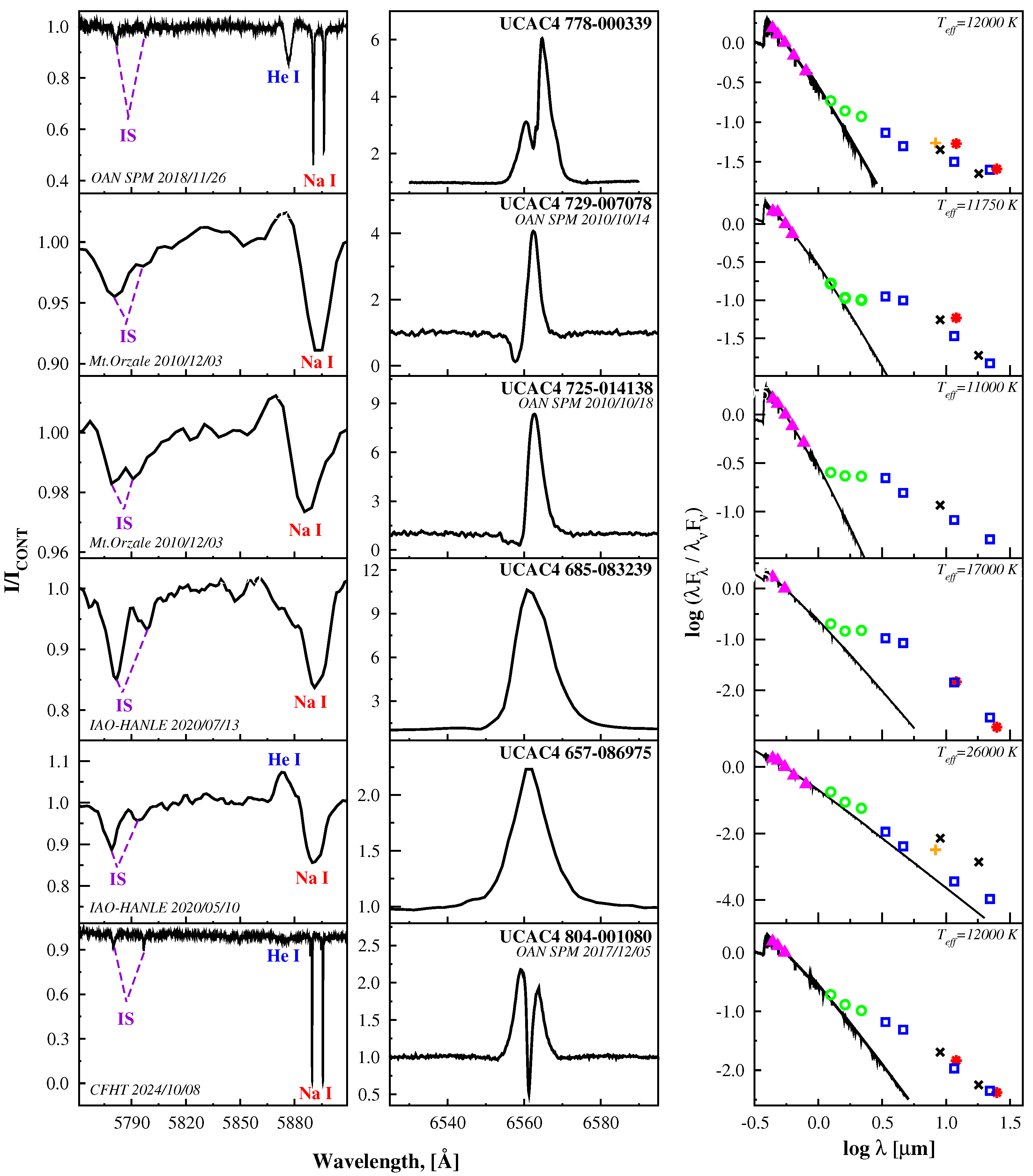
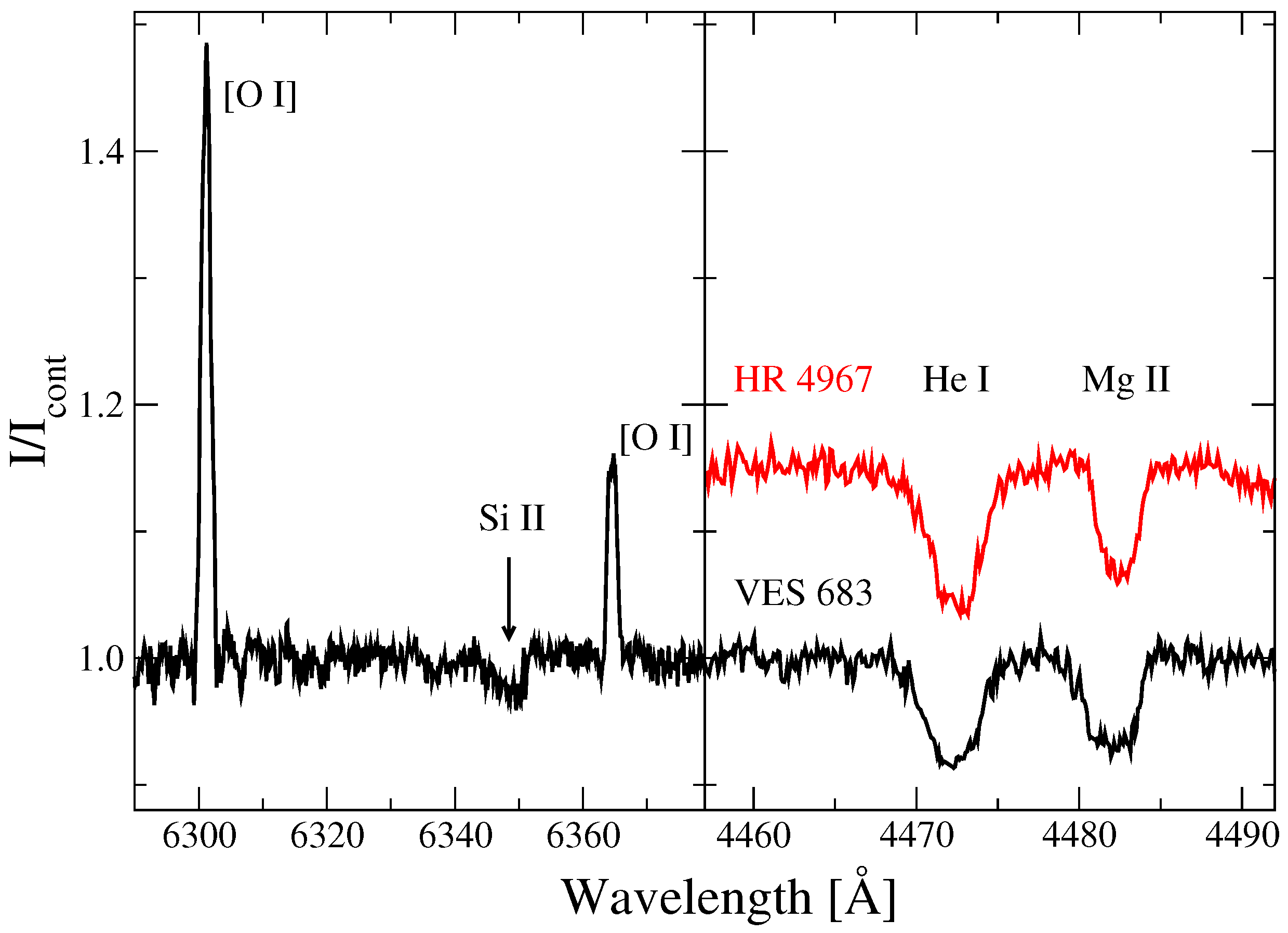
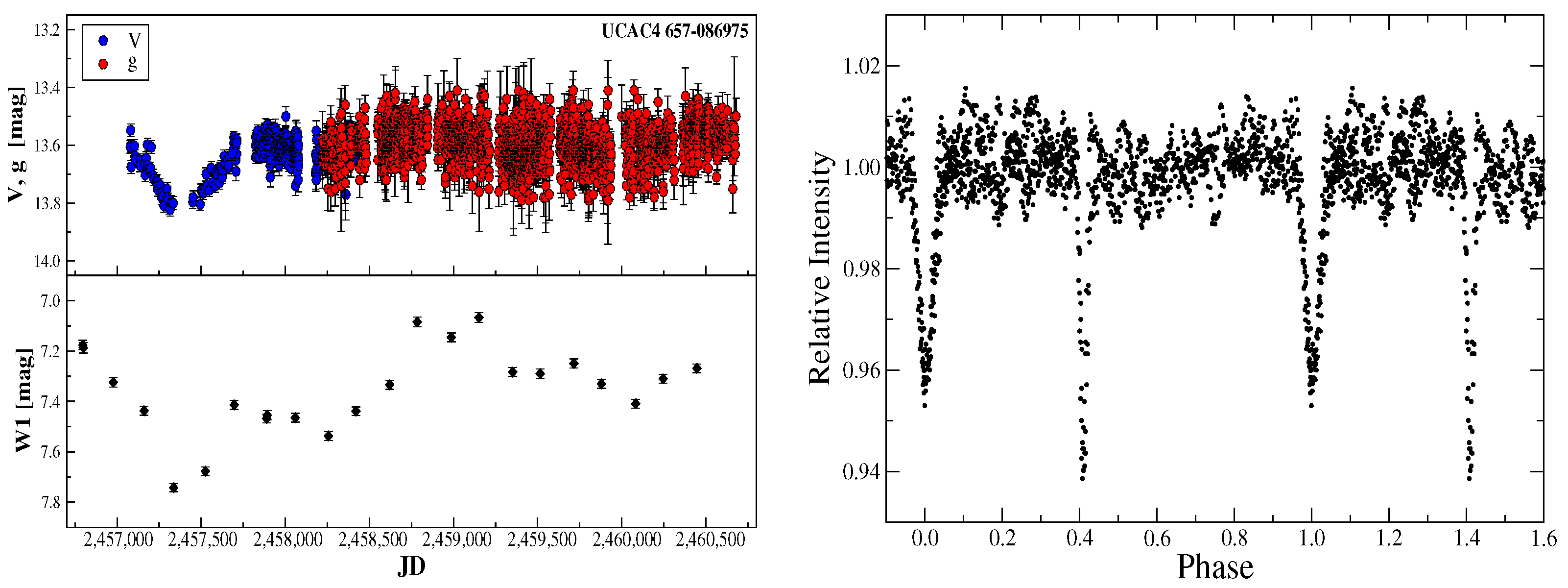
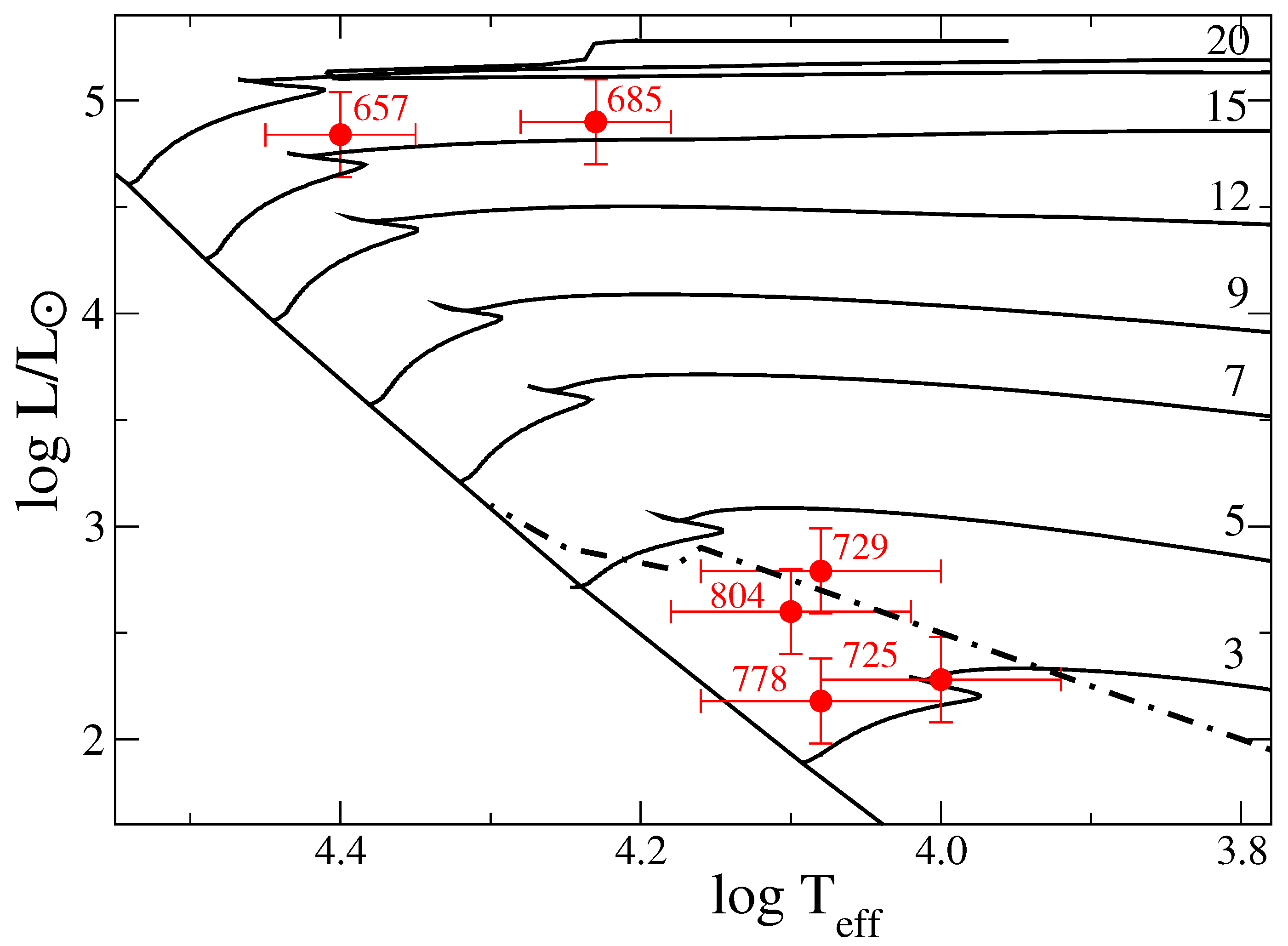
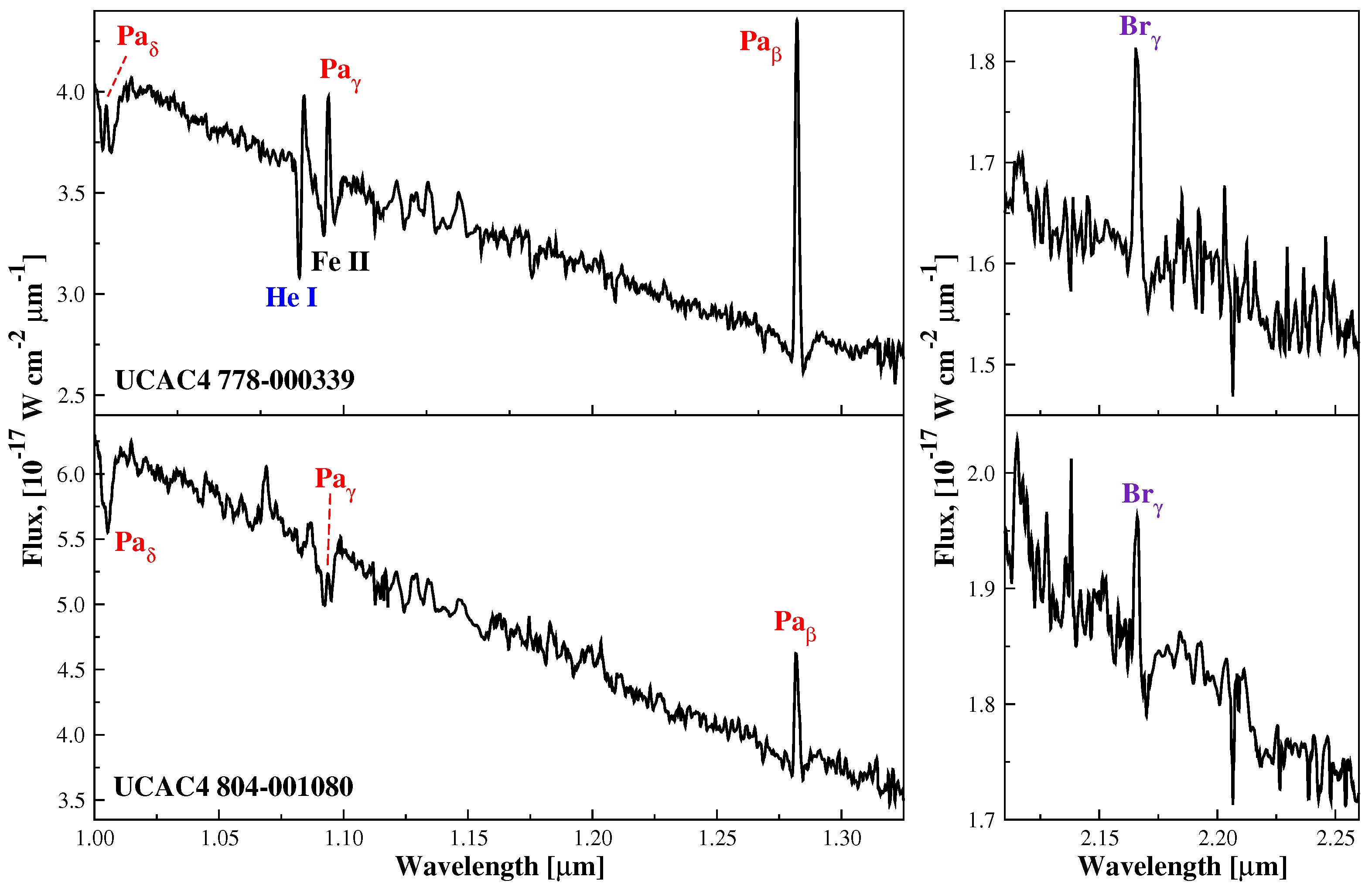
| UCAC–4 | l | b | V | K | E(B − V) | Teff | logL | EW Hα | Slope | Dist. |
|---|---|---|---|---|---|---|---|---|---|---|
| deg | deg | mag | mag | mag | K | L⊙ | Å | pc | ||
| 778–000339 | 118.3 | +3.1 | 11.4 | 8.44 | 0.7 | 12,000 | 2.18 | −29.6 | −0.7 | 705 (6) |
| 729–007078 | 121.9 | −7.1 | 12.6 | 9.52 | 0.8 | 11,750 | 2.79 | −9.9 | −1.1 | 2012 (42) |
| 725–014138 | 129.7 | −7.4 | 13.0 | 10.37 | 0.7 | 11,000 | 2.28 | −25.4 | −0.8 | 2346 (99) |
| 685–083239 | 85.6 | +2.9 | 14.7 | 7.53 | 2.1 | 17,000 | 4.92 | −110.3 | −1.9 | 6490 (525) |
| 657–086975 | 79.2 | +2.1 | 13.7 | 7.08 | 2.3 | 26,000 | 4.84 | −17.5 | − | 1778 (62) |
| 804–001080 | 120.6 | +7.9 | 11.2 | 8.26 | 0.8 | 12,000 | 2.60 | −9.2 | −1.5 | 971 (12) |
Disclaimer/Publisher’s Note: The statements, opinions and data contained in all publications are solely those of the individual author(s) and contributor(s) and not of MDPI and/or the editor(s). MDPI and/or the editor(s) disclaim responsibility for any injury to people or property resulting from any ideas, methods, instructions or products referred to in the content. |
© 2025 by the authors. Licensee MDPI, Basel, Switzerland. This article is an open access article distributed under the terms and conditions of the Creative Commons Attribution (CC BY) license (https://creativecommons.org/licenses/by/4.0/).
Share and Cite
Naurzbayeva, A.Z.; Alimgazinova, N.S.; Miroshnichenko, A.S.; Rossi, C.; Reva, I.V.; Kokumbayeva, R.I.; Omarov, C.T.; Zharikov, S.V.; Manset, N.; Raj, A.; et al. Searching for New Objects with the B[e] Phenomenon. Galaxies 2025, 13, 67. https://doi.org/10.3390/galaxies13030067
Naurzbayeva AZ, Alimgazinova NS, Miroshnichenko AS, Rossi C, Reva IV, Kokumbayeva RI, Omarov CT, Zharikov SV, Manset N, Raj A, et al. Searching for New Objects with the B[e] Phenomenon. Galaxies. 2025; 13(3):67. https://doi.org/10.3390/galaxies13030067
Chicago/Turabian StyleNaurzbayeva, Aisha Zh., Nazgul Sh. Alimgazinova, Anatoly S. Miroshnichenko, Corinne Rossi, Inna V. Reva, Raushan I. Kokumbayeva, Chingis T. Omarov, Sergei V. Zharikov, Nadine Manset, Ashish Raj, and et al. 2025. "Searching for New Objects with the B[e] Phenomenon" Galaxies 13, no. 3: 67. https://doi.org/10.3390/galaxies13030067
APA StyleNaurzbayeva, A. Z., Alimgazinova, N. S., Miroshnichenko, A. S., Rossi, C., Reva, I. V., Kokumbayeva, R. I., Omarov, C. T., Zharikov, S. V., Manset, N., Raj, A., Joshi, A., Rudy, R. J., Puetter, R. C., Perry, R. B., & Turekhanova, K. M. (2025). Searching for New Objects with the B[e] Phenomenon. Galaxies, 13(3), 67. https://doi.org/10.3390/galaxies13030067







